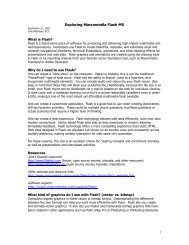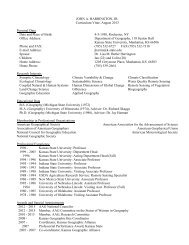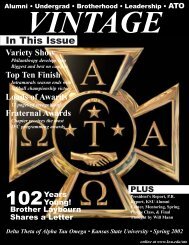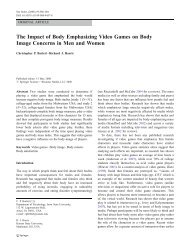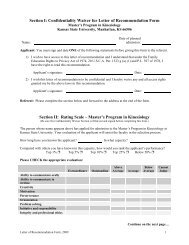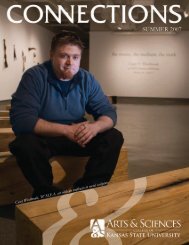book of records - Kansas State University
book of records - Kansas State University
book of records - Kansas State University
You also want an ePaper? Increase the reach of your titles
YUMPU automatically turns print PDFs into web optimized ePapers that Google loves.
Book <strong>of</strong> Records 7.17<br />
Due to the fact that the new house was being paid for, an attempt was made to hold the expenses for social<br />
events down as low as possible. It thus happens that no elaborate parties had been given by Delta Theta. However, the<br />
desire for a formal party could not be suppressed; and on May 19, 1922, a formal dinner dance was given--dinner being<br />
at the Gillett Hotel and the dance at the Elks= Hall. This was the first formal party ever given by the organization since<br />
its inception in 1912. A social custom inaugurated in 1921 was to have a picnic each Decoration Day.<br />
It sometimes happens that in an organization such as a chapter <strong>of</strong> a fraternity, there is one man who has made a<br />
name for himself such as few men can hope to make or ever will make. Delta Theta had such a man in its early years in<br />
the person <strong>of</strong> Ray B. Watson. Ray is commonly known as ATate@ among his brothers because when he was in the coal<br />
fields he had an insatiable appetite; and in order to appease this, to some extent he would carry with him a baked potato<br />
which he ate between meals. Everyone in the country who was a follower <strong>of</strong> track athletics had heard the name <strong>of</strong><br />
Watson, especially during the early 1920's when he had run several match races with Joie Ray <strong>of</strong> the Illinois Athletic<br />
Club who was heralded as the world=s premier middle-distance runner.<br />
Watson=s home was in Wichita, <strong>Kansas</strong>, and it was there that he went through high school. But while in high<br />
school, he was only a fair track man and he entered K. S. A. C. unknown for his ability on the cinder track. It was during<br />
his sophomore year that he began to attract notice by winning the one mile run at the <strong>Kansas</strong> City Athletic Club indoor<br />
meet in 4:40. During his last two years, he was a runner feared by all in the Missouri Valley. During these two years, he<br />
either won or purposely lost to a teammate every race, with two exceptions, which he entered in Missouri Valley<br />
Conference meets. These exceptions were both at all-Valley meets and in each case he had run a hard mile earlier in the<br />
meet, in one instance equaling the Valley record <strong>of</strong> 4:22.4, whereas the man who won each <strong>of</strong> these races had been fresh<br />
when he started. As has been mentioned before, he was captain <strong>of</strong> track during his senior year. He held the K. S. A. C.<br />
record for the mile at 4:21.6, and the Valley record for the two mile at 9:41. His fastest time in the half mile is 1:59.2.<br />
These last two were also former K. S. A. C. <strong>records</strong>.<br />
In the summer <strong>of</strong> 1920, Watson entered the tryouts for the Olympic Games. At Chicago, where the tryouts for<br />
this district were held, he won first place in the 5000 meter race. He had run a 4:12 in the mile, but the coach wanted<br />
him in the 5000 meter race. He then had to go to Boston for the final tryout. En route there, he stopped <strong>of</strong>f at New York<br />
to enter the tryout for the steeplechase. While this was the first time he had ever entered that event, he qualified for the<br />
team. While running this race, he stepped in a water hazard, and when he went to put his shoes on for the race in Boston<br />
a few days later he found the soles to be wrinkled and cracked from the effects <strong>of</strong> the water. It was then, however, too<br />
late to secure another pair before the race started. He had run only a little way before his feet became blistered and made<br />
running a great torture to him. He did not qualify in this race, and so went to the Olympics in Belgium entered in the<br />
steeplechase only. He placed seventh in this race to which he was not well adapted and bout which he knew little.<br />
In 1921, Brother Watson was first in the mile at the NCAA meet, with a time <strong>of</strong> 4:23.4. During the year, after<br />
his graduation, he took graduate work at K. S. A. C. and assisted in coaching the track team. He found time to keep trim,<br />
and beginning in the summer <strong>of</strong> 1921 he ran five match races with Joie Ray. Four <strong>of</strong> these had been mile races, two <strong>of</strong><br />
which had been won by each man. The other race was 1000 yards and was won by Joie Ray. The last event <strong>of</strong> the<br />
school year was the evening <strong>of</strong> May 27, 1922, when one <strong>of</strong> these match races was run on Ahearn Field, K. S. A. C. This<br />
race was especially noteworthy from the fact that it was run after dusk and the track was lighted by parking cars around<br />
the entire course and throwing the light from them on the track. This race was won by Joie Ray, but by only a very few<br />
inches. The remarkable time <strong>of</strong> 4:16.6 was made. It was believed that the world=s record would be broken by one or the<br />
other <strong>of</strong> these runners before long, and all Alpha Taus sincerely hoped that Watson would be the one to do it.<br />
In 1924, Brother Watson again made the Olympic team. He qualified in the 800 meter race by running the<br />
distance in 1:52.2 at Ann Arbor, Michigan, which was three-tenths <strong>of</strong> a second slower than the world=s record at that<br />
time. The Olympics were held in Paris, France.



